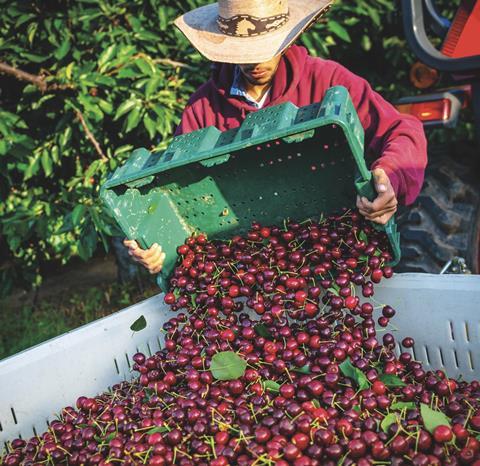Industry expects decreased volumes across Bing and Coral production
Erratic spring weather and two successive years of heavy production appear to have combined to produce a smaller, and somewhat delayed, 2025 California cherry crop.

“Picking for the very early varieties is expected to start around the end of April, as usual,” noted Washington State-based Dave Martin of Stemilt Growers. “The Tioga variety will come off first and we’ll stumble along as an industry through the second week of May when volume should start to pick up.”
However, Mark Calder of Primavera Marketing is concerned about a delay in peak volumes.
“The weather was pretty (volatile) during the bloom period throughout the state,” Calder said. “That could push peak volume into the third week of May, which is a concern because we may miss Memorial Day promotions in the East and Midwestern states.”
Just how much fruit California growers will have for sale this year is still unknown. It is all but certain, however, that production will be below the 9.8mn carton average of the last two seasons as the major Coral and Bing varieties look to have lighter sets.
“Coral looks to be down as much as 20 to 30 per cent (in the central San Joaquin Valley),” said Martin. “Poor chilling hours over the winter as well as weather this spring took a toll on the Coral bloom with maybe just 3 tonnes (of fruit) per acre compared to 5 tonnes last year.”
Calder added that Bing also saw poor bloom in the northern Stockton and Lodi regions this year.
“It wouldn’t be a surprise if only around 1mn cartons get shipped instead of the 2mn, we had last season,” he said.
Calder said that weather is the main culprit, plus steadily decreasing acreage for Bing. Though he expects at least one positive outcome from the lower volume this year as fruit sizing should improve.
Coral has emerged as the state’s acreage leader as growers continue to add plantings due to the variety’s higher yields and resilience to poor weather. Over the last two seasons of heavy volume, Bing packouts averaged around 2.2mn cartons while Coral averaged nearly 4mn. With production for both varieties likely to be down this season, total shipments could be hard pressed to reach 8m cartons.
Although California’s cherry production appears to be running somewhat late this year, the season is still expected to wind up by mid-June. If so, any overlapping production with the Pacific Northwest should be minimal.
“Based on the bloom onset, picking in the early districts of Washington should start the first week of June,” said Martin. “Volume should start to pick up by the week of 8 June. We are seeing good bud formation in the orchards, and this should result in a fairly large crop as long as the weather cooperates.”
Although exports to Asia have traditionally been an important element of California’s annual sales, factors beyond the industry’s control may limit shipments this year.
“Asian markets are nervous about tariffs and exchange rates,” said Martin. “We can only wait and see how things play out over the next few months.”
Calder agreed and said the continued strength of the US dollar is a real concern.
“Along with a short crop and [high] airfreight costs – California cherries could be quite expensive in Asia this year,” he said.



